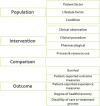Harmonization of the ICHOM Quality Measures to Enable Health Outcomes Measurement in Multimorbid Patients
- PMID: 34713068
- PMCID: PMC8521789
- DOI: 10.3389/fdgth.2020.606246
Harmonization of the ICHOM Quality Measures to Enable Health Outcomes Measurement in Multimorbid Patients
Abstract
Objectives: To update the sets of patient-centric outcomes measures ("standard-sets") developed by the not-for-profit organization ICHOM to become more readily applicable in patients with multimorbidity and to facilitate their implementation in health information systems. To that end we set out to (i) harmonize measures previously defined separately for different conditions, (ii) create clinical information models from the measures, and (iii) restructure the annotation to make the sets machine-readable. Materials and Methods: First, we harmonized the semantic meaning of individual measures across all the 28 standard-sets published to date, in a harmonized measure repository. Second, measures corresponding to four conditions (Breast cancer, Cataracts, Inflammatory bowel disease and Heart failure) were expressed as logical models and mapped to reference terminologies in a pilot study. Results: The harmonization of semantic meaning resulted in a consolidation of measures used across the standard-sets by 15%, from 3,178 to 2,712. These were all converted into a machine-readable format. 61% of the measures in the 4 pilot sets were bound to existing concepts in either SNOMED CT or LOINC. Discussion: The harmonization of ICHOM measures across conditions is expected to increase the applicability of ICHOM standard-sets to multi-morbid patients, as well as facilitate their implementation in health information systems. Conclusion: Harmonizing the ICHOM measures and making them machine-readable is expected to expedite the global adoption of systematic and interoperable outcomes measurement. In turn, we hope that the improved transparency on health outcomes that follows will let health systems across the globe learn from each other to the ultimate benefit of patients.
Keywords: health data interoperability; machine learning; outcomes measurement; patient centered; standardization.
Copyright © 2020 Blom, Khalid, Van-Lettow, Hutink, Larsson, Huff and Ingvar.
Conflict of interest statement
MI and SL are co-founders and members of the board of ICHOM and MK was an employee of ICHOM during the completion of this work. The remaining authors declare that the research was conducted in the absence of any commercial or financial relationships that could be construed as a potential conflict of interest.
Figures


Similar articles
-
Balancing adaptability and standardisation: insights from 27 routinely implemented ICHOM standard sets.BMC Health Serv Res. 2022 Nov 28;22(1):1424. doi: 10.1186/s12913-022-08694-9. BMC Health Serv Res. 2022. PMID: 36443786 Free PMC article.
-
Common patient-reported outcomes across ICHOM Standard Sets: the potential contribution of PROMIS®.BMC Med Inform Decis Mak. 2021 Sep 6;21(1):259. doi: 10.1186/s12911-021-01624-5. BMC Med Inform Decis Mak. 2021. PMID: 34488730 Free PMC article.
-
Bridging the gap: Can International Consortium of Health Outcomes Measurement standard sets align outcomes accepted for regulatory and health technology assessment decision-making of oncology medicines.Pharmacol Res Perspect. 2021 Apr;9(2):e00742. doi: 10.1002/prp2.742. Pharmacol Res Perspect. 2021. PMID: 33749172 Free PMC article.
-
A Standard Set of Value-Based Patient-Centered Outcomes for Breast Cancer: The International Consortium for Health Outcomes Measurement (ICHOM) Initiative.JAMA Oncol. 2017 May 1;3(5):677-685. doi: 10.1001/jamaoncol.2016.4851. JAMA Oncol. 2017. PMID: 28033439
-
Harmonization in laboratory medicine: Requests, samples, measurements and reports.Crit Rev Clin Lab Sci. 2016;53(3):184-96. doi: 10.3109/10408363.2015.1116851. Epub 2015 Dec 15. Crit Rev Clin Lab Sci. 2016. PMID: 26667798 Review.
Cited by
-
Balancing adaptability and standardisation: insights from 27 routinely implemented ICHOM standard sets.BMC Health Serv Res. 2022 Nov 28;22(1):1424. doi: 10.1186/s12913-022-08694-9. BMC Health Serv Res. 2022. PMID: 36443786 Free PMC article.
-
On the Annotation of Health Care Pathways to Allow the Application of Care-Plans That Generate Data for Multiple Purposes.Front Digit Health. 2021 Sep 8;3:688218. doi: 10.3389/fdgth.2021.688218. eCollection 2021. Front Digit Health. 2021. PMID: 34713160 Free PMC article.
References
-
- Feeley TW, Mohta NS. New Marketplace Survey: Transitioning Payment Models: Fee-for-Service to Value-Based Care. Boston, MA: NEJM Catalyst. (2018) 4.
-
- What Is Value-Based Healthcare? Boston, MA: NEJM Catalyst. (2017) 3.
LinkOut - more resources
Full Text Sources

